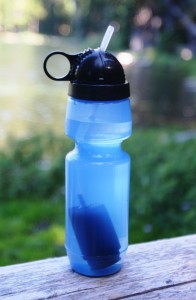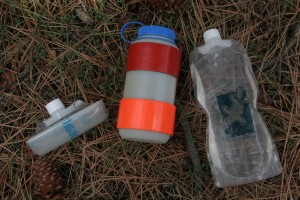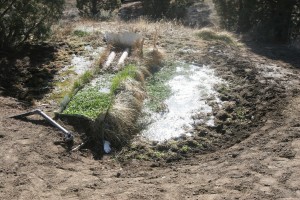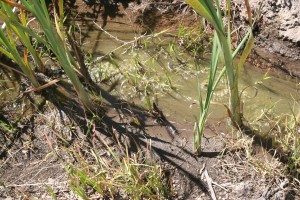In a disaster, no single item or piece of gear can absolutely guarantee your ability to purify water for drinking. But several carefully-chosen pieces of water purification equipment might give you a fighting chance!
by Leon Pantenburg
As a newspaper reporter covering various natural disasters, including tornadoes, floods and forest fires, I noticed a common aspect among all of them: Drinking water was always in short supply.
My first flood taught me that. I was working for the Vicksburg Evening Post and was sent to photograph the high water in Chickasaw Bayou, north of Vicksburg, MS. The nearby Mississippi River had reclaimed some of its flood plain, sending high water into a subdivision and forcing residents to leave.
I rode in a jonboat with a sheriff’s deputy, and we cruised the flooded streets. It
was Mississippi summer hot, the heat reflected off the muddy, nasty water and the bottom of the metal boat, and the deputy and I baked in the sunshine.
Though there were miles and miles of water, there was not one drop to drink (to update and steal a cliche from “The Rime of the Ancient Mariner”). I would have gotten really thirsty, except the deputy was prepared with extra water and willing to share!
I’m not sure anything could have made that vile floodwater stew after Katrina potable! But regardless of where you
The Sport Berkey Portable Water Purifier can be a valuable addition to any urban and/or wilderness survival kit.
are, staying hydrated is one of your first priorities.
 Where I live in Central Oregon, I am within striking distance of high desert, mountains, temperate rain forests, the Pacific coast and beautiful deciduous forests. I love to roam all these areas, and frequently, during hunting season, may end up miles from the vehicle and my backup water supply. But these areas all require different variations of hydration gear, and here’s how to decide what will work best for your region.
Where I live in Central Oregon, I am within striking distance of high desert, mountains, temperate rain forests, the Pacific coast and beautiful deciduous forests. I love to roam all these areas, and frequently, during hunting season, may end up miles from the vehicle and my backup water supply. But these areas all require different variations of hydration gear, and here’s how to decide what will work best for your region.
Here’s an important consideration before choosing hydration gear:
How long will it take to work? Some sport bottle systems work instantaneously – you fill them up, prime the filter and drink. This can invaluable if you need to quickly re-hydrate a child or someone who is dehydrated to the point of medical emergency.
The chemical treatments, such as the Polar Pure, can require upward of 30 minutes to work, depending on the water temperature. Some filters just take a long time to work. Generally speaking, boiling is not a particularly quick operation. The time it takes to boil water varies, depending on altitude, heat source, shape of container etc.
Here’s what I carry as part of my hydration system, and so far, everything has served me well. (Many of these items are multi-use):
Water Containers: You must have durable, large capacity water containers available. If you’re out all day in the desert or a flood, for example,
The Nalgene in the center is what I drink from and the Platypus flexible bottles on either side are backups.
on either side are backups.
there probably won’t be a place or chance to replenish your drinking water, and all you’ll have is what you carry. Also, you might find someone without any water at all. You don’t want to give away your backup!
- Nalgene bottle: I like the wide-mouth model, and modify mine with a paracord loop and duct tape. The loop is designed so the bottle can be carried on my belt, or tied to a cord to lower into a stock tank, depression or water source that is hard to get to. Don’t think you can just tie something onto the lid retainer – chances are it will break at some point, and as these things go, probably when you need it the most.
Duct tape is useful for everything, and around the water bottle is a convienent place to carry it!
- Platypus flexible water containers: These collapsible water containers are available in various sizes as water storage units and they roll up into a small, lightweight pack when empty. I generally carry two or three large-sized extras, rolled up and empty, in my daypack, since they weigh next to nothing and don’t take up much space. Then, if you need to carry water from a spring or other water source, you won’t have to improve. (Tip: Since you will probably need a minimum of a gallon of water per day, it makes sense to take enough flexible water containers to haul a gallon!)
Tin or metal cup for boiling or dipping water out of hard-to-reach places. Boiling water is probably the safest, most effective method of water purification available, providing you have a heat source, and a tin cup works great and is incredibly useful.
I usually carry a large (about 24-ounce capacity), metal cup for several tasks. My trusty, large blue enamel cup and a spoon comprised my mess kit for nine days in the Boundary Waters in northern Minnesota. I never needed anything else. I have brewed countless cups of tea or coffee over various heat sources with that piece of gear, and I don’t leave home without one!
 How long should you boil the water to purify it? Bring the water to a boil, and that should kill anything that boiling will
How long should you boil the water to purify it? Bring the water to a boil, and that should kill anything that boiling will
This Central Oregon high desert spring is the only water source for miles. The water will require purification before using.
kill. Water boils at 212 degrees, then vaporizes. Extended boiling will not make the water hotter or kill more nasties, but it will use up more of your fuel!
Polar Pure or Potable Agua: These are chemical purifiers, and require a certain time period for them to work. I used the Polar Pure system exclusively on a nine-day canoe trip in Minnesota’s Boundary Waters and the system worked really well. Potable Agua comes in capsules and is easy to carry and use. Either Polar Pure of Potable Aqua goes on every outing.
Six-foot piece of aquarium tubing: I got this tip from survival expert Peter Kummerfeldt. Peter recommends including the tubing in case you find water in a crack or crevice and can’t get to it. Just stick the tube in the water and suck it out.
Coffee filter and bandanna: If you can filter the mud and debris out of the water, it will make any filter last that much longer. In especially turbid, muddy water, wrap the coffee filter around the bottom of any filter and attach it with a rubber band. It will help! The bandanna has many uses, including serving as a water filter. A clean one, that you haven’t used to wipe your nose, is preferable!
Large garbage bag: Another multi-use item. Use this to catch rain or dew, or as a reservoir for holding water.
Water filter: Some lightweight method of filtering and purifying water can be incredibly useful. I field-tested the Berkey Portable Water Filter, and I like it. Several companies make similar products.
“The bottle’s filter is designed to remove and/or dramatically reduce a vast array of health-threatening contaminants from questionable sources of water,” according to Berkey, ”including remote lakes and streams, stagnant ponds and water supplies in foreign countries where regulations may be sub-standard at best.”
If the water is really nasty, the Berkey folks recommend two drops of plain chlorinated bleach or iodine be added to each refill before filtering. This will kill minute pathogens such as viruses, according to the brochure, and the disinfectant will then be filtered from the water entirely removing its odor, color and taste.
So, these items work for me. My hydration system is set up with the idea that there is a piece of equipment that should be able to handle any situation. Do your research, select your equipment carefully and include an integrated hydration system in every survival kit.
And make sure to use your common sense to stay hydrated in the first place!
Source: survivalcommonsense.com



